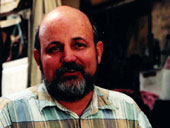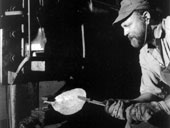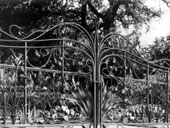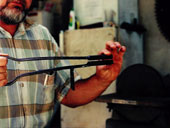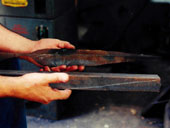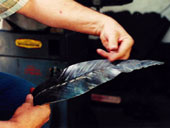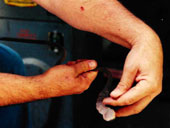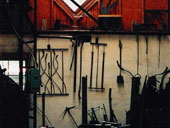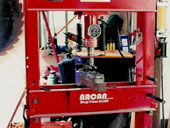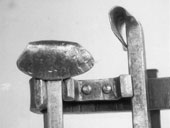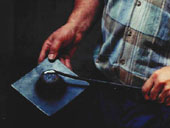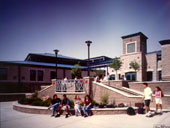Learning Library Segments
Lars Stanley
Primary Use of Medium: Forging & Blacksmithing MetalInterviewer: Donna Wetegrove
Interview Location This interview takes place with Lars Stanley in his open air blacksmithing shop on a beautiful, sunny early Fall afternoon.
Interview Date: 9.16.99
Writer: Donna Wetegrove
Inspiration
Art Form/Product
Green Aspects
Marketing Values
Special Offering
Additional Comments
Artist Profile
Inspiration
"There is something more profound about how buildings effect people; good buildings are buildings that move you. They have certain qualities about them and that quality has something to do with the people who built them and the spirit they put into it. It seemed it would reflect their energy. I didn't understand that at first intuitively I knew something was there". "That had him choose a craft... he chose metalwork."What Type Of Artist Do You See Yourself As?
"I call myself an architect and a craftsman or artisan a blacksmith."
How Did You Get Here?
Not trained as an artist but trained as an architect, Lars points out "my desire to understand architecture is what has driven my understanding of how art and craft integrates into architecture". "I like to work with my hands architecture involves building but typically an architect doesn't get involved with the actual building." That was what really interested him. After graduating from college, Lars worked initially with craftspeople. He went from a field engineer on a big building to working with a carpenter, a cabinetmaker, a welder and in a sheet metal shop. He comments how it helped him understand the relationship between what architects do; to understand the translation, integration and process as design becomes "brick and mortar". It is important for him to understand the integration between idea and execution.
"I figured in my mind that if I was going to understand craftsmanship or artisianry, I needed to become one with it somehow; to really get into the material, understand it more profoundly, and see where it went." "In that process, now I realize that the energy that is put into the material physically manifests itself in the hammer mark or in the form then it is radiated back. It is reflected in how people respond to it. The response is what everybody has in common, although it may be a different response."
"People respond to an art object or a building or a space that has certain qualities like this universally. It is a universal language. So that was really intriguing to me and that is what led me to pursue the metal work, to understand that connect better. But it wasn't a deliberate intellectual decision. It involved that, but initially it was an intuitive path or decision to follow."
Where Does Your Inspiration Come From?
His mentors are his parents. His mother is an artist. Lars is clear that she taught him the patience of sticking with a project even though it was frustrating. His dad is an architect. Lars has worked with him since he was ten years old. His dad would point out the craftsmanship of the buildings in El Paso, where he grew up; the brick joints' uniformity from tooling, their work and their care. "The kinds of things that, when you stand back, you don't recognize why it strikes you you just think this building is neat. You become aware, aware of the energy."
There were other mentors also. Texas A & M professor John Ferry made him aware of the process of doing things and the effect of doing it and the intent. "Doing something you intend to be a certain way and you work at that. Then it is translated back."
Sculptor Alex Weygers (http://www.alexweygers.com/), in California, whom Lars studied blacksmithing with taught him through his lifestyle. Alex was trained as an engineer but that was not where his love was. After working as an engineer for a while, he quit. Moving to California to live on some land, he declared that he was going to be a sculptor; then proceeded to study with a sculptor. Alex would say, "you know the important thing here is to figure out what you love to do. Don't you worry about fame, money or any of these intellectual aberrations and pursue the love; that other stuff will happen. If it doesn't happen immediately, you continue to do it because you love it and get over the differences that arise no matter what you are doing."
Charles Moore, when teaching at the University of Texas at Austin graduate school, "taught me how to appreciate architecture and human energy on a larger scale". "Buildings are receptacles of human energy energy of the artist or the architect designing the space, the banker that provides the money or the zoning codes that locate it. The buildings are the receptacles and they reflect this energy. When you are aware of this, you can use this and create a building that has a beneficial energy; to affect people in the world positively. That is an important concept to understand a difficult one to understand." Lars points out that Charles conveyed this concept with very few words and through travel study programs. He would also bring people in to speak to the students that had affected him personally. One such person that stands out in Lars' mind is J. B. Jackson, a New England philosopher and landscape journalist whose focus was to understand the landscape and the highway. Lars describes J. B. as an 80 year old man who lectured at Harvard and at Berkley, constantly on the move between the two coasts, 5 ft. 2 inches tall and riding a big motorcycle. "He was a story teller about travels" who moved to New Mexico and worked at a filling station in Santa Fe. Lars recalls J.B. always being anxious to return home to his job, to the dismay of all the students. J.B. would clarify that at the filling station, he would clean travelers' tires and windshield, pump gas, etc. "This is how I study the road. I ask people where they have been, what their experiences were and get a chance to understand the vehicle better." "He would gather the information and write these incredible stories and use it in his lectures." For Lars, it was good to see someone who didn't feel they had to pursue a traditional path that we are "given" because it seems like the right thing to do like working for a big firm if you are going to be an architect. J. B. made his own program and made a big impact on people. "You can make up your own program, and when you do, all these wonderful things happen."
Charles Moore also brought in Kent Bloomer (http://www.bloomerstudio.com/), who taught the language of ornament at Yale. "Bloomer pointed out why ornament evolved in human history and how important the craftsman was to ornament. Metalwork was a part of that." Lars reminds us that the buildings at the University of Texas have much ornament and symbols that are archetypes to their meaning and use. "He opened our eyes to it. It would be elitist to say we don't need that today in our modern world. We miss out on a lot of power and profoundness because it is easy to intellectualize it out when it is more difficult to understand that." "That's why I do it" Lars comments.
Clearly Lars' inspiration also comes "from the client and the situation I am dealing with; the environment I am dealing with". He uses the recently completed grillwork at the University of Texas tower as an example. "The students wanted to reintegrate the tower back into their lives. The architectural staff at UT needed to address the barrier situation and wanted an elegant arc. I used that concept and refined it turning it into an exhilarating experience, which mainly stems from the place. Up there, looking out is inspirational. The tower is meant to be inspirational; the focal point of the campus and the community a sacred place." Part of what Lars and his team had to deal with was to release the catastrophic history of the tower so it didn't dominate the feeling up in the tower and then re-express the tower and possession of it. "Creating a transforming experience, like the education you are supposed to get at UT it is a powerful symbol." Lars points out that the barrier they created was nothing glamorous. "Intuitively you know what to do, what to pursue." "You have to learn that on your own and they worked with the original details of the building to create a barrier that releases some energy through a collaborative process."
Lars goes on to comment, "the artist is one of the few members of society that does deal with his intuition; does deal with these more ancient concepts that our more intellectual Western society has rejected. The artist and the artisan become the elite as the interpreters of that. Our society is transforming as we see the value of the artisan again" in comparison to Renaissance times.
Art Form/Product
"It seems like an ideal medium to pursue."Why Do You Like The Medium?
"The flame and the transformation of the material when you heat it with the flame. It becomes white hot and just for a little bit, it becomes a metaphorical medium. So it's like when you have an idea, there is a transformation that comes in a snap. It doesn't always happen. It doesn't necessarily happen over a long period."
"It just has a lot of metaphors with qualities of a building that moves you. That is what led me to metal."
Does The Material Dictate The Design Or Does Your Design Idea Dictate How The Material Is Used?
"You can do it both ways. My interests have developed to see how the metal affects the design instead of forcing my will and having it look like something else." Lars prefers an integration of the idea and the material. The Zilker Gardens entrance gate is a good example. The gate needed to be representative of all the garden groups (of which there are more than 100). In a programming effort with all of them, the live oak tree was the most representative plant of all the groups at this certain place in this time. Lars allowed the process of forging to dictate how the plant was formed. He made a tool that would make impressions in the steel and spread it at the same time; the spreading of the steel would naturally curve it, which would allow him to duplicate the form and the essence of the leaf. "But it was abstracted and immediate."
As Lars rummages in his scrap pile, he emerges with the components and tool that clearly could be recognized to the finished products. "Each leaf is different as it evolved from common angle iron into a wonderful natural form." An abstraction of a cast iron plant and a reed are examples he showed. "It reflects the material, it reflects the process, it reflects the idea. That is what is interesting to me and that is what translates directly to architecture."
What Brings Your Medium To Life?
"The forging process in particular. You heat the metal up; it becomes white hot; you work it and when you are working it, you are very much alive, very much aware of what you are doing if you don't want to get burned", he adds. "So you have to practice, practice, practice. After you practice, like anything else, your intuition adopts the knowledge about it and that is translated into your work. So every artists' personality is translated into their work. It seems like an ideal medium to pursue."
What Tools Are Required In Your Process?
The tools are one of the things that attracted Lars to metalwork.
He had been working in wood at the time and was about to start carving, but tools were expensive so he thought he would make his own. Lars went to the bookstore. As he recalls, "The Making of Tools" by Alexander G. Weygers, presented itself. "The book was about taking old scrap steel, old springs and making tools. That's what got me on the road to making metalwork."
Over the years, finding tools has helped Lars appreciate that "tools are extensions of the human mind." "They allow you to interact with nature and with materials as extensions of your hands. Tools are the saving grace of Western society because we have made all these tools and used our intellect and praised logic and reason with the computer being the ultimate tool. But back to the essence of the tool, it is a real intuitive and a spiritual thing. People's personal tools become the holders of their energy."
"Tools are a profound thing," Lars admits. Blacksmithing tools hold expressions of an ever more profound reality for Lars. "They are like sculptures of their own. Take, for instance, the shape of the anvil, which has evolved over centuries. One blacksmith started out with just a stone; another understood how to cast bronze to make an anvil so you could get a corner and he cast it into a square. Then they learned about steel so they put a horn on it so you could get round shapes; then added a little step because another needed to add a certain bend. Then they put a hole in it so you could punch into the steel. The anvil is now a record of human ingenuity from intuitive reactions to nature, to the material. All the tools are like that."
The old power hammer in Lars' shop, made in 1951, is one of his main tools and "they don't make this model any more." "There are new ones invented that run off compressed air that are also wonderful, but were not available in the 70's when I was getting started." Lars had to find his tools in scrap piles of industrial companies and had restored them to get them going again. His air hammer came from a scrap yard in San Angelo where it had been retired when blacksmithing became obsolete in the Industrial Age. The new tools certainly have a different feel to them than the old ones.
Do You Consider It Functional Art?
Lars comments that blacksmiths are one of the few crafts that make their own tools and the tools for other trades.
"Functional in an active way it also causes you to feel a certain way; exhilarated, or however you may respond. Blacksmithing is interactive art, architectural art like a door pull. You actually, physically deal with and touch with more than your eyes. It's a different sense."
Please speak About The Connections In Metalwork.
"All connections serve a practical purpose; they also express an idea and they reflect an overall understanding of what they are doing. So, they can create a rhythm, a pattern; they can totally change how you feel about a space or product."
"The UT tower is a perfect example. The connections a lot of the time are all you have to work with. They wanted to reflect the connections already on campus, the heritage of the campus. Their scale and rhythm help to alleviate the fact that it is a barrier. Then it becomes a screen or latticework you look through. In a way, it releases you from being aware of this barrier to the view beyond. The connections help do that."
"A weld is considered a more modern connection" where heating the metal up is part of the process. Lars loves traditional blacksmithing connections riveted connections or collar banded connections. "They are so strong and so direct a powerful composition. The scale of the band and the method used and how tight it is all matters in the care and thought; the work it takes to taper to ends. "Anybody can tell that. A child can tell that. It is universal. It reflects your overall approach to life."
Of course, the environment the piece will be in, the budget, and the type of client all play a significant part in what type of connection is used in the overall artistic effect as well, Lars points out.
Please Summarize Your Entire Process.
"A design project is a door handle or designing a school, they have similar threads," and Lars enjoys doing both of them. He sees them being very related. Both need to reflect who he is and who the client is. "That's why they come to me and want it to reflect a certain quality. Certain social aspirations, ideas and feelings will be generated. If you are not aware of that, the things that will dominate will be the politics of it and the economics of it zoning, codes all part of that energy to be resolved. It takes time to absorb it and come up with a good result."
"I follow the process I learned in architecture school. First step is information gathering/programming. To talk to the client, go see the site, understand the requirements and objectives, their aspirations. From that process, ideas pop up. The client always has an idea of what is going to move them what moved them about my work because they have seen something and it appeals to them in a certain way. That draws something out from me and I will do sketches. Sometimes I get them to do some sketches. It evolves. Ideas come that way."
"I will go into the design phase. Schematic design comes up with some schemes through sketches that try to express the inspirations that evolved; two or three options. The client will then look at them; we will talk about them and refine it. That will evolve into the design that we settle on." Through design development, Lars includes his client in the process because he values their energy. "They are an important part of it." "The final design is reflective of a budget that affects the connections, etc."
"Next step is to set the price, set the time frame, and start." Lars has a team of people that he works with in his shop and he has also collaborates with other shops if the scope of the project dictates it. He will show his in-house team what he wants by forging an example and having them practice till it is reflective of his example; till it becomes an intuitive process. As long as the intent is captured, Lars allows the team he is mentoring to gain valuable experience to fulfill their purpose for working with him. "I invest in them to the extent that they learn how to do something, do these processes which helps them and it helps me so I can work on several things." He is there along the whole way and he encourages questions.
Lars and his crew will usually do their own installations; especially so if it is a tricky situation, like a gate, where he wants it to function smoothly as a reflection of its quality and his work.
Lars is typically best known for his metalwork over his architectural work. However, he has a crew so he can do both they are connected to him.
Do You Recommend What You Do As A Career Choice? Why?
"I would recommend that they try a lot of things out then try to see what they love to do. Whatever that is, that would be their career choice. Even if they change their path when they are 40 years old. As long as they try to keep in mind this is this what I love to do, and it could change again. That is what presents opportunities and that is what makes things exciting."
"You do have to worry about making a living. You do have to go to college and get a degree. In the process of doing that, keep in mind a degree plan and do it. If something else presents itself, follow that and do it with all you heart until something happens that tells you to change direction." "With all you heart" is the key in that statement.
"You can't tell where you are going to go. I didn't know what my business would be like now. I had a lot of questions from peers." Lars knew he had to follow his heart and intuition of what fit for him. "This is a viable business. I am making a good living at it. But I didn't know this business would exist beforehand when I started doing this in the 70's. The business kind of creates itself; kind of like the design process. It comes out of the surroundings and awareness of listening to your heart and other people. This is my impression; everyone will have their own. I didn't really evaluate this intellectually as a business in wondering how much money am I going to make. Though this is a valid tool after you know more about what you want to do and why you are doing it. If you make your decisions in life based on money and economics then you are probably not going to be happy. You can see a lot of examples of people who are wealthy but not happy. How do you want to spend your time on the earth?"
What Tips Might You Have For Someone New To The Medium? How Best To Develop Their Interest?
"If someone feels the urge to do this, go to work in a shop. Find out who is doing what. Get some art magazines, sculpture magazines and craft magazines and pour through them; see what workshops there are about this medium and try to expose yourself to the ones that appeal to you. Visit the artist; sit in on a class or workshop make yourself aware. Figure out how; intend to have what your goal is to happen." Lars did just that for himself when he wanted to meet Charles Moore and did so by enrolling in his graduate class. "It changed my life."
Green Aspects
"A green approach mainly means an understanding and respect for nature and the world we live in the physical and the psychological world we live in." "If you are an artist and you are creating these pieces that move people then you are creating this beneficial energy which is the overall objective of green efforts."Please Point Out Any "Green" Aspects Of Your Process And Your Medium.
"Green meaning in harmony with the earth is something I have really focused on in my work. I see craft as being an art totally capable and integrated or expressed in green principles or sustainable design."
Lars has been picked by the City of Austin to help evaluate their project guidelines within the current Green Builder Program for a goal of obtaining consistent results.
"Western society addresses it in the more intellectual aspects of it by suggesting we use certain materials to not, for instance, use up a lot of BTU's (British Thermal Unit, or amount of energy) to extract from the earth principles like that." "Those are very important, but I think art deals with these other principles that are just as important. You tend to ignore them, unless you are an artist. How do you wake up and greet the world? What things do you have around you? What kind of energy do they produce in you? Art deals with that."
"If you are an artist and you are creating these pieces that move people, then you are creating this beneficial energy which is the overall objective of green efforts. The end result is to create a world we want to live in. That concept is assisted immensely by artwork. It makes you feel like you are glad to be alive. That is the essence of sustainable design dealing with the sun, dealing with light coming into a building. That is understanding another aspect of nature and how you deal with the heat and light of the sun; how it affects the economics and how much energy it uses to cool to space or to light it. It translates directly whether it is artwork or sustainable architecture."
Marketing Values
"How do you wake up and greet the world? What things do you have around you? What kind of energy do they produce in you? Art deals with that."Please Talk About Making Multiples Of A Creative Effort As A Part Of Your Business.
Lars' work is primarily commission based. He has not really gotten into making multiples of a product type as a business base. He does concur, however, that there are a few pieces he has made with that intent some candle holders, for example. Other business continues to come in that does not leave him time to develop that, although he says he likes the aspect of multiples. "One of the best reasons is an understanding I gained by reading "The Unknown Craftsman: A Japanese Insight into Beauty". In there he talks about the vessels made by Korean potters that inspired the Japanese tea ceremony and the notion of the unknown craftsman being the purveyor of the wisdom of the culture. The first person in Korea that made these tea vessels taught other people in his village how to do this. People in that village would move and teach another village until there was this whole region of people who created these vessels that have a wonderful spontaneous expression of their spirit and their wisdom. The wisdom came from some artist or combination of artists who said this is how we make these things; this is how we interact with this clay, and this is how we are expressing who we are to the world. The Japanese loved this, tried to copy it, and it evolved into a tea ceremony where the vessel is so important. It becomes an object of energy to them where the detail and glaze are all important. Korean craft people and artists were actually a representation of the wisdom and inspiration of their whole culture. Even though it could have been made by a child or a very old person, the spirit of how they made it was conveyed through the original artist. Over time, it evolved and changed with the input of each artist. It expressed each person, but it also expressed the original idea. The author of "The Unknown Craftsman: a Japanese Insight into Beauty", was trying to make the point that everyone doesn't have to be this profound artist; you don't have to recreate this original art that is a Western notion. All these people are heroes who are making these repetitive things. But they are not repetitive because they are handmade and express the human individual." A very positive way to look at repetition!
The notion that stands out for Lars in this philosophy is that "the vessels were made without any pretense; without a lot of intellectualizing. The child would learn how to do it from the master and it was quick. It was the joyful expression that was quick as the child would do another one; it was not labored upon. That notion of doing it quickly and trying to capture the essence of the material and idea was what helped guide Lars to develop the idea of the leaf process for the Zilker Gardens entrance gate. "It reflected the artist, the material and the process. You can see that in architecture too; like cathedrals that may have been constructed by farmers. Making repetitive things can express that same idea."
Where Do You See Your Creativity Evolving?
"I have no idea. I just want to feel like I am following my heart and doing what I think is right."
Lars is very interested in school design. Franklin High School in El Paso, Texas, is one facility where he was able to bring some of his ideas and philosophies into the design of that school; focusing on plazas and student spaces that encourage community and interaction for social sustainability a Renaissance concept that is time tested. Lars is very proud of this project and wants to do more like it to positively effect our world with his principles of sustainable techniques and get the budgets to incorporate functions like gray-water systems, rainwater collection systems, natural lighting, xeriscaping, etc. "The most important thing is the spaces in the building being part of the kids' lives and their day to day impact them in a beneficial way."
On a trip back to the school, Lars discovered a wonderful social feature that evolved as Franklin High students became integrated with the structure. It had to do with the entrance/parent drop off area. Tons of kid were on the benches, planters and steps around this loop. It was a ritual to initiate the freshman's transition to sophomores. The kids had to go around this parent loop backwards on all fours with a spoon and an egg without dropping it. If dropped, they had to start over till they made it as the rest of the school cheers them on in this race. "That wasn't part of the design program," Lars commented, and yet it was wonderful to see. "They had taken possession of this building and it was an alive space. If there had not been these benches, planters and steps in that space, then perhaps, that would not have happened and this social opportunity turned tradition would be missed."
Another example of social sharing at the same school is the flagpole in the middle of that same loop. While kids are waiting for their parents after school, the ROTC kids come and take the flag down while everyone can watch another daily ritual integrated into their gathering.
Special Offering
"The end result is to create a world we want to live in."Additional Comments
"I don't understand the dichotomy between the formal artist and the crafts. To me, it doesn't make sense. I understand it intellectually but in reality, it is a foolish distinction."In metal, there is a good vehicle for learning more at Austin Community College. "They have blacksmithing classes, which is quite unusual. Not many places in the country have that. You can get direct exposure right away." Lars teaches how to use the power hammer periodically at ACC.
Make sure you visit Lars' at his website: www.larsstanley.com
Artist Profile:
Lars StanleyStanley Architects & Artisans
2007 Kinney Ave.
Austin, Texas 78704
512/445-0444
www.larsstanley.com
Thank you for utilizing TIPS On Art Learning Segments On The Web to further your understanding of the process of artists and art forms. Please take a few minutes to fill out our website survey. Through your feedback, and by making special requests of us for future segments, we will know how TIPS On Art has impacted your situation.

